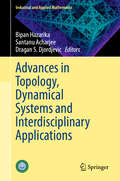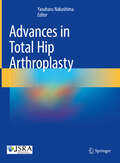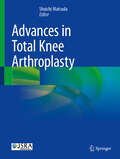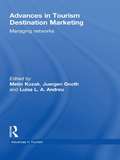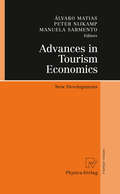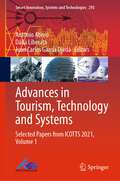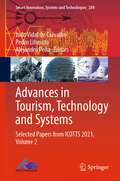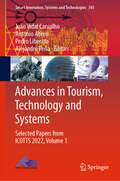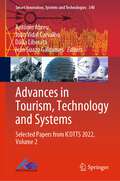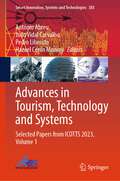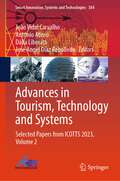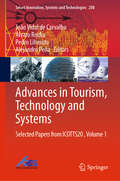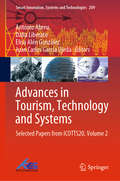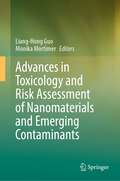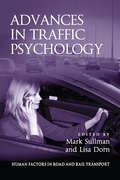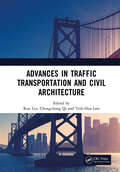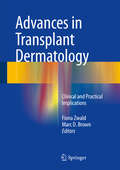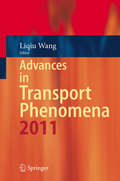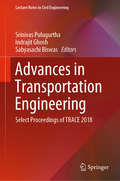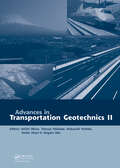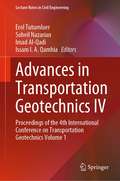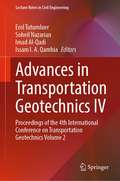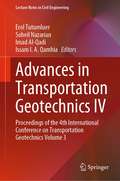- Table View
- List View
Advances in Topology, Dynamical Systems and Interdisciplinary Applications (Industrial and Applied Mathematics)
by Bipan Hazarika Santanu Acharjee Dragan S. DjordjevicThis book contains selected chapters on topology and dynamical systems and their interdisciplinary applications. Targeting researchers in interdisciplinary areas, the book covers contemporary interdisciplinary topics in topology and dynamical systems, such as closure functions, Partially Negative Dimensional Product (PNDP) manifolds, Khalimsky topological subspaces, neutrosophic topological space, ideal topological spaces, relator spaces, predator–prey symbiosis, cosmological models, and nanofluids.
Advances in Total Hip Arthroplasty
by Yasuharu NakashimaThis book provides comprehensive, evidence-based surgical principles and techniques for total hip arthroplasty (THA), covering all aspects of this procedure, including the history, biomaterials, biomechanics, surgical techniques and other important issues. Beginning with an overview of the hip joint and its anatomy, the authors detail the biomechanics of the hip joint in its various states and further discuss the properties of biomaterials in arthroplasty. The book describes the principles of surgical technique, preoperative planning, surgical procedures, rehabilitation, and management of complications, and thoroughly illustrates surgical procedures to enhance the reader's understanding. The book also introduces the technical aspects of the procedure, including how to deal with difficult cases such as severely deformed cases and how to increase the safe range of motion. Advances in Total Hip Arthroplasty is written by a pioneering team of authors in cooperation with the Japanese Society for Replacement Arthroplasty (JSRA). The book is informative and provides practical tips for THA and academic insights for orthopedic surgeons and residents specializing in arthroplasty. The translation was done with the help of an artificial intelligence machine translation tool. A subsequent human revision was done primarily in terms of content.
Advances in Total Knee Arthroplasty
by Shuichi MatsudaThis book describes in full detail the surgical principles and technology of Total Knee Arthroplasty (TKA), providing evidence-based data on the biomechanics of the knee joint and biomaterials in arthroplasty. Starting the chapters with the history and anatomy, the book expands its focus on important issues such as implant designs of articular geometry and ligament substitution. It describes the thorough procedures of surgery from planning, operation, discussion on how to improve the range of motion, postoperative rehabilitation and also patient satisfaction. In chapters describing the surgical procedures, and approaches, step-by-step surgical techniques are shown to manage various severe deformities. Also, the clinical relevance of surgical techniques including soft tissue balancing and alignment of the components and computer-simulated studies are of importance to highlight. Advances in Total Knee Arthroplasty invite authors who are surgeons who have extensive experience in severely deformed joints. This book is collaborated with the Japanese Replacement Arthroplasty Society (JSRA), and it is an informative material for collecting academic insights for arthroplasty surgeons and orthopaedic residents. The translation was done with the help of artificial intelligence. Subsequently, human revisions were made, mainly in terms of content. Subsequently, stylistic revisions were made by a specialized copy editor.
Advances in Tourism Destination Marketing: Managing Networks (Advances in Tourism)
by Metin Kozak Juergen Gnoth Luisa L. A AndreuThis volume provides original insight into the operational opportunities, challenges and constraints in managing Tourism Destination Marketing. It explores how the various tourist destination systems including tourist, places (as seen by the tourist), public and private tourism organisations and the social and physical environment can effectively communicate and co operate together at a profit for each. Advances in Destination Marketing offers a comprehensive review of a wide range of aspects related to marketing tourism products including networks in destinations, consumer experiences in destinations, destination branding, destination image, events in destinations and destination tourism products. Throughout the book a network analysis perspective is applied to offer alternative solutions of how each system can share network knowledge and system knowledge so profits can be created effectively and maximised. The exploration of new topics such as Destination Networks and Destination Branding as well as original international empirical research and case studies from well known researchers in the area, provides new thinking on Marketing Tourism Destinations. The relevance of the arguments and the salient conclusions are valuable in the study of an ever dynamic and burgeoning industry. This stimulating volume will be of interest to higher level students, academics, researchers within Tourism and practitioners in the industry.
Advances in Tourism Economics: New Developments
by Peter Nijkamp Manuela Sarmento Álvaro Matias'Advances in Tourism Economics' follows his predecessor 'Advances in Modern Tourism Research' (2007) in providing a thorough assessment of state-of-the-art economic research in this rapidly developing field. The authors start by analyzing the recent upsurge of model-based economic research in the field, which builds on powerful tools in quantitative economics, such as discrete choice models, social accounting matrices, data envelopment analyses, impact assessment models or partial computable equilibrium models including environmental externalities. The volume originates from this novel research spirit in the area and aims to offer an attractive collection of operational research tools and approaches. It forms an appealing record of modern tourism economics and positions the field within the strong tradition of quantitative economic research, with due attention for both the demand and supply side of the tourism sector, including technological and logistic advances.
Advances in Tourism, Technology and Systems: Selected Papers from ICOTTS 2021, Volume 1 (Smart Innovation, Systems and Technologies #293)
by António Abreu Dália Liberato Juan Carlos Garcia OjedaThis book features a collection of high-quality research papers presented at the International Conference on Tourism, Technology & Systems (ICOTTS 2021), held at the University of Cartagena, in Cartagena de Indias, Colombia, from 4 to 6 November 2021. The book is divided into two volumes, and it covers the areas of technology in tourism and the tourist experience, generations and technology in tourism, digital marketing applied to tourism and travel, mobile technologies applied to sustainable tourism, information technologies in tourism, digital transformation of tourism business, e-tourism and tourism 2.0, big data and management for travel and tourism, geotagging and tourist mobility, smart destinations, robotics in tourism, and information systems and technologies.
Advances in Tourism, Technology and Systems: Selected Papers from ICOTTS 2021, Volume 2 (Smart Innovation, Systems and Technologies #284)
by Pedro Liberato João Vidal de Carvalho Alejandro PeñaThis book features a collection of high-quality research papers presented at the International Conference on Tourism, Technology & Systems (ICOTTS 2021), held at the University of Cartagena, in Cartagena de Indias, Colombia, from 4 to 6 November 2021. The book is divided into two volumes, and it covers the areas of technology in tourism and the tourist experience, generations and technology in tourism, digital marketing applied to tourism and travel, mobile technologies applied to sustainable tourism, information technologies in tourism, digital transformation of tourism business, e-tourism and tourism 2.0, big data and management for travel and tourism, geotagging and tourist mobility, smart destinations, robotics in tourism, and information systems and technologies.
Advances in Tourism, Technology and Systems: Selected Papers from ICOTTS 2022, Volume 1 (Smart Innovation, Systems and Technologies #345)
by António Abreu Pedro Liberato Alejandro Peña João Vidal CarvalhoThis book features a collection of high-quality research papers presented at the International Conference on Tourism, Technology and Systems (ICOTTS 2022), held at University of Chile, Santiago de Chile, Chile, from 3 to 5 November 2022. The book is divided into two volumes, and it covers the areas of technology in tourism and the tourist experience, generations and technology in tourism, digital marketing applied to tourism and travel, mobile technologies applied to sustainable tourism, information technologies in tourism, digital transformation of tourism business, e-tourism and tourism 2.0, big data and management for travel and tourism, geotagging and tourist mobility, smart destinations, robotics in tourism, and information systems and technologies.
Advances in Tourism, Technology and Systems: Selected Papers from ICOTTS 2022, Volume 2 (Smart Innovation, Systems and Technologies #340)
by António Abreu Dália Liberato João Vidal Carvalho Iván Suazo GaldamesThis book features a collection of high-quality research papers presented at the International Conference on Tourism, Technology and Systems (ICOTTS 2022), held at University of Chile, Santiago de Chile, Chile, from 3 to 5 November 2022. The book is divided into two volumes, and it covers the areas of technology in tourism and the tourist experience, generations and technology in tourism, digital marketing applied to tourism and travel, mobile technologies applied to sustainable tourism, information technologies in tourism, digital transformation of tourism business, e-tourism and tourism 2.0, big data and management for travel and tourism, geotagging and tourist mobility, smart destinations, robotics in tourism, and information systems and technologies.
Advances in Tourism, Technology and Systems: Selected Papers from ICOTTS 2023, Volume 1 (Smart Innovation, Systems and Technologies #383)
by António Abreu Pedro Liberato João Vidal Carvalho Hazael Cerón MonroyThis book features a collection of high-quality research papers presented at the International Conference on Tourism, Technology and Systems (ICOTTS 2023), held at Anáhuac University, Bacalar, Mexico, from 2 to 4 November 2023. The book is divided into two volumes, and it covers the areas of technology in tourism and the tourist experience, generations and technology in tourism, digital marketing applied to tourism and travel, mobile technologies applied to sustainable tourism, information technologies in tourism, digital transformation of tourism business, e-tourism and tourism 2.0, big data and management for travel and tourism, geotagging and tourist mobility, smart destinations, robotics in tourism, and information systems and technologies.
Advances in Tourism, Technology and Systems: Selected Papers from ICOTTS 2023, Volume 2 (Smart Innovation, Systems and Technologies #384)
by António Abreu Dália Liberato João Vidal Carvalho José Angel Díaz RebolledoThis book features a collection of high-quality research papers presented at the International Conference on Tourism, Technology and Systems (ICOTTS 2023), held at Anáhuac University, Bacalar, Mexico, from 2 to 4 November 2023. The book is divided into two volumes, and it covers the areas of technology in tourism and the tourist experience, generations and technology in tourism, digital marketing applied to tourism and travel, mobile technologies applied to sustainable tourism, information technologies in tourism, digital transformation of tourism business, e-tourism and tourism 2.0, big data and management for travel and tourism, geotagging and tourist mobility, smart destinations, robotics in tourism, and information systems and technologies.
Advances in Tourism, Technology and Systems: Selected Papers from ICOTTS20 , Volume 1 (Smart Innovation, Systems and Technologies #208)
by Álvaro Rocha Pedro Liberato João Vidal de Carvalho Alejandro PeñaThis book features a collection of high-quality research papers presented at the International Conference on Tourism, Technology & Systems (ICOTTS 2020), held at the University of Cartagena, in Cartagena de Indias, Colombia, from 29th to 31st October 2020. The book is divided into two volumes, and it covers the areas of technology in tourism and the tourist experience, generations and technology in tourism, digital marketing applied to tourism and travel, mobile technologies applied to sustainable tourism, information technologies in tourism, digital transformation of tourism business, e-tourism and tourism 2.0, big data and management for travel and tourism, geotagging and tourist mobility, smart destinations, robotics in tourism, and information systems and technologies.
Advances in Tourism, Technology and Systems: Selected Papers from ICOTTS20, Volume 2 (Smart Innovation, Systems and Technologies #209)
by António Abreu Dália Liberato Elisa Alén González Juan Carlos Garcia OjedaThis book features a collection of high-quality research papers presented at the International Conference on Tourism, Technology & Systems (ICOTTS 2020), held at the University of Cartagena, in Cartagena de Indias, Colombia, from 29th to 31st October 2020. The book is divided into two volumes, and it covers the areas of technology in tourism and the tourist experience, generations and technology in tourism, digital marketing applied to tourism and travel, mobile technologies applied to sustainable tourism, information technologies in tourism, digital transformation of tourism business, e-tourism and tourism 2.0, big data and management for travel and tourism, geotagging and tourist mobility, smart destinations, robotics in tourism, and information systems and technologies.
Advances in Toxicology and Risk Assessment of Nanomaterials and Emerging Contaminants
by Liang-Hong Guo Monika MortimerThis book details the state-of-the-art methodological advances for delineating the toxicology and working mechanisms of nanomaterials, microplastics, fine aerosol particulates (PM2.5) as well as emerging organic pollutants. It also provides latest computational approaches for toxicity prediction and risk assessment of nanoscale materials which possess realistic chances to enter the environment and human organism. Written by leading scientists at the frontiers of environmental science and nanomedicine, this book is intended for both young researchers and experienced professionals working in the fields of environmental protection, human health and occupational safety, nanotechnology, material science and nanomedicine, as well as graduate students majoring in environmental and health sciences.
Advances in Traffic Psychology (Human Factors in Road and Rail Transport)
by Mark SullmanTraffic psychology is a rapidly expanding and broad field within applied psychology with a considerable volume of research activities and a growing network of academic strands of enquiry. The discipline primarily focuses on the behaviour of road users and the psychological processes underlying these behaviours, looking at issues such as cognition, distraction, fatigue, personality and social aspects, often delivering practical applications and educational interventions. Traffic psychology has been the focus of research for almost as long as the motor car has been in existence and was first recognised as a discipline in 1990 when the International Association of Applied Psychology formed Division 13: Traffic and Transportation Psychology. The benefits of understanding traffic psychology are being increasingly recognised by a whole host of organisations keen to improve road safety or minimise health and safety risks when travelling in vehicles. The objective of this volume is to describe and discuss recent advances in the study of traffic psychology, with a major focus on how the field contributes to the understanding of at-risk road-user behaviour. The intended readerships include road-safety researchers from a variety of different academic backgrounds, senior practitioners in the field including regulatory authorities, the private and public sector personnel, and vehicle manufacturers concerned with improving road safety.
Advances in Traffic Transportation and Civil Architecture: Proceedings of the 5th International Symposium on Traffic Transportation and Civil Architecture (ISTTCA 2022), Suzhou, China, 19-20 November 2022
by Teik-Hua Law Run Liu Chongchong QiAdvances in Traffic Transportation and Civil Architecture focuses on the research of traffic infrastructure. This proceedings gathers the most cutting-edge research and achievements, aiming to provide scholars and engineers with a preferable research direction and engineering solutions as reference. Subjects in this proceedings include: - Road Engineering- Bridge Engineering- Tunneling- Construction Technology and Processes The works of this proceedings aim to promote the development of civil engineering and construction technology. Thereby, promote scientific information interchange between scholars from the top universities, research centers and high-tech enterprises working all around the world.
Advances in Transitional Flow Modeling: Applications to Helicopter Rotors (SpringerBriefs in Applied Sciences and Technology)
by Chunhua ShengThis book provides a comprehensive description of numerical methods and validation processes for predicting transitional flows based on the Langtry-Menter local correlation-based transition model, integrated with both one-equation Spalart-Allmaras (S-A) and two-equation Shear Stress Transport (SST) turbulence models. A comparative study is presented to combine the respective merits of the two coupling methods in the context of predicting the boundary-layer transition phenomenon from fundamental benchmark flows to realistic helicopter rotors. The book will of interest to industrial practitioners working in aerodynamic design and the analysis of fixed-wing or rotary wing aircraft, while also offering advanced reading material for graduate students in the research areas of Computational Fluid Dynamics (CFD), turbulence modeling and related fields.
Advances in Translational Neuroscience of Eye Movement Disorders (Contemporary Clinical Neuroscience)
by Aasef Shaikh Fatema GhasiaA comprehensive book that reviews advances in ocular motor research on topics of general interest, rare, specialized or unique conditions, and pertinent basic neuroscience. A rare collection with contributions from basic neuroscientists, neurologists, and ophthalmologists. Includes dedicated chapters on mathematical models, pharmacotherapy, neuromodulation, motion perception, visual influence on eye movement, physiology of strabismus, and microsaccades. This book is dedicated to David Robinson - one of the pioneers of contemporary ocular motor and vestibular neuroscience.
Advances in Transplant Dermatology: Clinical and Practical Implications
by Fiona Zwald Marc D. BrownThis book provides an informative update on scientific advances relating to transplant dermatology that may be applicable to clinical practice. Commentary is provided on the emerging role of viruses in transplant dermatology, the management of skin disease secondary to transplant medication, sunscreen use in transplant recipients, the role of revision of immunosuppression, and advances in photodynamic therapy. The latest staging and management criteria for high-risk squamous cell carcinoma and the implications for clinical practice are then analyzed. Finally, the management of other cutaneous malignancies is discussed, covering malignant melanoma, Merkel cell carcinoma, and rarer tumors that also behave aggressively and require special consideration in solid organ transplant patients. Each particular advance is addressed in an individual chapter by leaders in the field. The book both expands current knowledge and complements previous textbooks on the subject.
Advances in Transport Phenomena 2011 (Advances in Transport Phenomena #3)
by Liqiu WangThis new volume of the annual review "Advances in Transport Phenomena" series contains three in-depth review articles on the microfluidic fabrication of vesicles, the dielectrophoresis field-flow fractionation for continuous-flow separation of particles and cells in microfluidic devices, and the thermodynamic analysis and optimization of heat exchangers, respectively.
Advances in Transportation Engineering: Select Proceedings of TRACE 2018 (Lecture Notes in Civil Engineering #34)
by Srinivas Pulugurtha Indrajit Ghosh Sabyasachi BiswasThis book comprises select papers presented at the International Conference on Trends and Recent Advances in Civil Engineering (TRACE 2018). The book covers cutting-edge methods and applications in the field of traffic control, transportation planning, road maintenance, and highway and pavement engineering. Case studies on traffic safety, pedestrian behavior, and highway maintenance and design are also presented in this book. The contents of this book are useful for researchers and practitioners working in transportation and traffic engineering.
Advances in Transportation Geotechnics 2
by Seiichi Miura Tatsuya Ishikawa Nobuyuki Yoshida Yoshio Hisari Nagato AbeThis book (including a 969 pages full paper USB device) deals with the geotechnics of roads, railways and airfields. Providing economic and sustainable transportation infrastructures for societies is highly dependent on progress made in this field, and the contributions are of interest to professionals and academics involved in geotechnical and pavement engineering of roads, railways and airfields.
Advances in Transportation Geotechnics IV: Proceedings of the 4th International Conference on Transportation Geotechnics Volume 1 (Lecture Notes in Civil Engineering #164)
by Imad Al-Qadi Erol Tutumluer Soheil Nazarian Issam I. A. QamhiaThis volume presents selected papers presented during the 4th International Conference on Transportation Geotechnics (ICTG). The papers address the geotechnical challenges in design, construction, maintenance, monitoring, and upgrading of roads, railways, airfields, and harbor facilities and other ground transportation infrastructure with the goal of providing safe, economic, environmental, reliable and sustainable infrastructures. This volume will be of interest to postgraduate students, academics, researchers, and consultants working in the field of civil and transport infrastructure.
Advances in Transportation Geotechnics IV: Proceedings of the 4th International Conference on Transportation Geotechnics Volume 2 (Lecture Notes in Civil Engineering #165)
by Imad Al-Qadi Erol Tutumluer Soheil Nazarian Issam I. A. QamhiaThis volume presents selected papers presented during the 4th International Conference on Transportation Geotechnics. The papers address the geotechnical challenges in design, construction, maintenance, monitoring, and upgrading of roads, railways, airfields, and harbor facilities and other ground transportation infrastructure with the goal of providing safe, economic, environmental, reliable and sustainable infrastructures. This volume will be of interest to postgraduate students, academics, researchers, and consultants working in the field of civil and transport infrastructure.
Advances in Transportation Geotechnics IV: Proceedings of the 4th International Conference on Transportation Geotechnics Volume 3 (Lecture Notes in Civil Engineering #166)
by Imad Al-Qadi Erol Tutumluer Soheil Nazarian Issam I. A. QamhiaThis volume presents selected papers presented during the 4th International Conference on Transportation Geotechnics. The papers address the geotechnical challenges in design, construction, maintenance, monitoring, and upgrading of roads, railways, airfields, and harbor facilities and other ground transportation infrastructure with the goal of providing safe, economic, environmental, reliable and sustainable infrastructures. This volume will be of interest to postgraduate students, academics, researchers, and consultants working in the field of civil and transport infrastructure.
